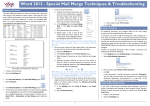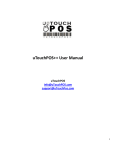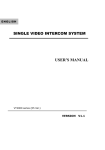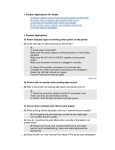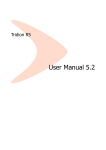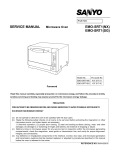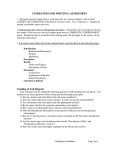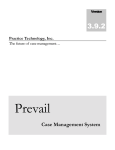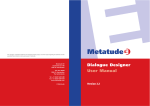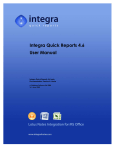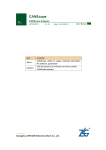Download DuraLabel 4TTP Users Guide - DuraLabel Sign and Label Printers
Transcript
DuraLabel 4 User’s Guide TTP INTRODUCTION Welcome... And congratulations on the purchase of your new DuraLabel 4 Thermal Transfer Printer! We've included this guide to get you printing as quickly as possible. In this guide you'll find information on setting up your printer, configuring your software, and creating custom labels. We know that all topics cannot be addressed in any document, and are ready to answer your questions. If you have any questions or concerns, make sure to give us a call! Graphic Products, Inc. 1-800-788-5572 CONTENTS Getting Started ................................... Prepare the Printer ......................... Install the Printer Drivers ............... Driver Configuration ....................... 2 2 3-8 9-13 Load Supplies...................................... 14 Ribbon.............................................. 15-18 Label Media..................................... 19-22 Label Creation .................................... Using Templates ............................. Setting up the Document ............... Select the Printer ............................ Optimize the Print Properties ........ Changing the Page Setup .............. Orientation ...................................... 23 24 24 24 25-27 27 28 Label Design ...................................... Text .................................................. Graphics .......................................... Symbols ........................................... Barcodes ......................................... Sequencing ..................................... Importing from Excel....................... 29 29-30 31-32 33-34 35-36 37-40 41-46 Cleaning the Print Head & Cutter...... 47-48 Extensive Cleaning of Cutter........... 49-56 1 GETTING STARTED Installing the Printer Driver for: Windows 2000/Windows XP/Windows NT Prepare the printer IMPORTANT: You must have administrative rights in order to perform this installation. Instructions for unpacking, loading supplies and connecting your printer are located in the User’s Manual (in printed or electronic form). There is also an instructional To begin, click Install at the bottom right corner of your DuraLabel 4TTP Installation video included on he CD which shows you how to load supplies. Please read and CD screen. This will bring up a License Agreement window. On the next window, follow those instructions carefully before continuing. accept the terms of the license agreement and click Next. Note: To view the electronic version of the manual you will need a corresponding document viewer (PDF or DOC). Two suitable viewers are included on the installation CD - Adobe Acrobat Reader and Microsoft Word Viewer. Install the printer drivers With the DuraLabel 4 connected and powered on you are ready to install the printer drivers and software. When you place the CD in the drive, it should autorun within a few seconds.* When the autorun begins, the DuraLabel 4 menu will appear on your screen. Click on the button Install Driver. The program will now guide you through the installation of your printer driver. Note: Find out your Windows version by right-clicking on the My Computer icon (located on your desktop). Select the Properties option. Your Windows version is located under the System heading. *If the CD does not autorun you may need to manually install your printer drivers. To manually install, double-click on the CD. Verify the installation directory chosen. The default is “C:\Seagull” If you plan to print RTK labels: After you’ve installed the drivers, click the Install RTK Software button on the DuraLabel 4 startup screen, and the RTK Software will be installed on your computer. When the installation screen opens, you can click More Information to see more info on the installation process or simply click Automatic Install to begin. To use the RTK Software, the print driver and the DuraLabel 4 itself must be set up. See the introduction section of the help page in the software and follow the directions there. To align the printing and cutting of the labels, see the problem solving section of the help page for clear instructions. 2 3 Select any options desired on the final screen and uncheck the second option, Select either Local or Network for your printer driver. If you select Local, make sure “Read Installation Instructions,” then click Finish. the “Automatically detect and install my Plug and Play printer,” is unchecked. To Add Printer Select the port you would like your printer use. IMPORTANT: You must have administrative rights in order to add a printer under Windows XP. An “Add Printer Wizard” window should have appeared on your screen; click Next. RTK LABELS If you are going to print RTK labels, see the setup instructions in the RTK software documentation. See Introduction on the Help Menu page. 4 5 *IMPORTANT! Click on Have Disk, not “next.” OPTIONAL: If you had previous Seagull Scientific drivers installed, click “Replace existing driver.” The listings in these boxes will differ with each user and will not match what you see here. In the space provided, type “C:\Seagull” and click OK. Enter DuraLabel 4TTP for the printer name and select Yes if you want it to be set as your default printer, then click Next. Select the TSC TTP-342M Plus for the printer and then click Next. Decide if you would like to share the printer with other network users, then click Next. 6 7 Choose if you would like a test print to ensure proper installation, then click Next. Configure the Windows 2000/Windows XP/Windows NT Printer Driver IMPORTANT! Perform the driver configuration before opening the document you wish to print. The following instructions are for printing on continuous rolls of vinyl. To begin, access the DuraLabel 4TTP Printer Properties by clicking the Start >> Settings >> Printers. This will bring up the Printers folder: Make sure your settings are correct , if so select Finish otherwise select Back and change to the correct settings. Right-click on the DuraLabel 4TTP and select Printing Preferences from the dropdown menu. This will bring up the DuraLabel 4 TTP Printing Preferences. Click on the Page Setup Tab. A dialog box will appear regarding Hardware Installation, click Continue Anyway. Your driver should be installed and you should be ready to set up for printing. 8 9 Under Stocks, select “USER (4.00 in x 6.00 in)” and click Edit. This brings up the The Graphics Tab under Dithering allows you to adjust the contrast of colors. Do not Edit Stock dialog box. apply dithering to monochrome (one color or no gray) sections of printing because it may appear fuzzy. Select None then click Apply when all settings have been made. Set the Label Width and Label Height to 4.00 x 40.00. Take note of the Exposed Liner Width measurements, as they should be set to “0” if printing on continuous rolls of media. Click OK when finished. You can use this stock when printing any label that is 4.00 by 40.00 in. or smaller. Since you won’t need the other stock sizes, select and delete each one using the delete button. You should now have one stock named “USER (4.00 in x 40.00 in).” 10 11 To set the cutter, select the Stock Tab. Set the Media Settings “Type” to Continuous. To cut labels in intervals, you may do so by setting the “Occurrence” to After In order for the automatic cutter to cut after each label, under Media Handling next Specified Interval under the Stocks Tab. Set the Interval to the number of labels to “Post-Print Action” select Cut and then next to “occurrence” select After Every needed. Click Apply to save your settings. Page. These settings may be later adjusted to your specifications in the Printer Properties as you are printing your labels. Select Apply on the bottom of the Printing Preferences window. Adjusting the Print Speed and Darkness To set up for printing on die-cut labels your settings will be set differently under the Print Speed is adjusted in increments of .5”/sec. from 1.0 to 2.0”/sec. The Stocks Tab. For die-cut labels with the 1/8” gap, the settings should be as Darkness is adjusted from 0 to 15 in increments of 1. The Graphics Format settings follows: “Method” should be set to Thermal Transfer and the “Type” should be set to should not be adjusted. Leave them at Automatic. Labels With Gaps, “Gap Height” set to 0.12 (default) and “Gap Offset” to 0 (default). When finished with your settings, click OK. Your driver is now set-up and you are ready to create your labels! 12 13 Load Supplies Loading of Ribbon Structure of DuraLabel 4 TTP *Please view our supply loading video online at www.DuraLabel.com 1) With the lid open and the front of the machine is facing forward, open the Ribbon Mechanism (2, pg. 14) by pulling the Printer Carriage Release Lever (3, pg. 14) forward, until the Ribbon Mechanism pops up. 2) Take the Ribbon Rewind Spindle (5, pg. 14) off and place an empty core on, then with the flange of the Ribbon Rewind Spindle on the right-hand side, first put the left side of the Ribbon Supply Spindle in the provided spot of the Ribbon Mechanism and then the right side (with flange). Figure 1. Interior view 1. Printer Cover (in open position) 2. Ribbon Mechanism 3. Printer Carriage Release Lever 4. Printed Label Opening 5. Ribbon Rewind Spindle 6. Ribbon Supply Spindle 7. Label Supply Roll Spindle 8. Memory Module Slot (with cover on) 9. Fixing Tabs 10. PAUSE Button 11. PWR., ON_LINE, ERR. Indicators 12. FEED Button 14 Figure 2. Ribbon Mechanism in open position with a core applied to the Ribbon Rewind Spindle. 15 3) Take the Ribbon Supply Spindle (6, pg. 14) with the flange on the right side and 5) Thread the Ribbon Supply underneath the Ribbon Mechanism. put the Ribbon Supply on it with the Ribbon Supply facing towards the back of the machine and extending over the top of the Ribbon Supply Spindle. 4) With the Ribbon Supply facing towards the back of the machine and the flange of the Ribbon Supply Spindle is on the right side, first put the left side of the Ribbon Flange of the Spindle is on the right-hand side of the machine. Supply Spindle in the provided spot of the Ribbon Mechanism and then the right side (with flange). Figure 3. Flange of the Spindle should be on the right-hand side of the machine as demonstrated above. Figure 5. Ribbon Supply applied correctly. *TIP: Look under the Ribbon Mechanism to make sure the Ribbon Supply is not covering the word ‘RIBBON’ that is on the inside of the machine under the Ribbon Mechanism.. Figure 4. Step 3 Loading of Ribbon Supply on the Ribbon Supply Spindle. White arrow demonstrates which end of the Ribbon Supply Spindle is inserted into the Ribbon Supply. 16 17 6) Tape the entire length of the end of the Ribbon Supply to the core on the Rewind Structure of DuraLabel 4 TTP Ribbon Spindle and roll the Ribbon Rewind Spindle forward a few times to secure the Ribbon Supply around the Ribbon Rewind Spindle and to eliminate any wrinkles, fingerprints or flaws. 5 Figure 7. Feed labels through adjustable label guide 1. Printer Carriage Release Lever 2. Platen 3. Label Media 4. Adjustable Label Guide 5. Media/Vinyl Sensor Figure 6. Ribbon Supply taped to the Ribbon Rewind core. The Ribbon Supply should be in place and ready for Label Media to be inserted. Figure 8. Feed labels through adjustable label guide 1. Label Supply Roll Spindle 2. Label Roll Mount 3. Label Roll 4. Fixing Tabs 18 19 Loading of Label Media 4) Thread the Label Media under the Ribbon Mechanism and through the Printed Label Opening (#4, pg. 14) and leave a little excess Media out the other side. *Please view our supply loading video online at www.DuraLabel.com 5) Adjust the Adjustable Label Guides (Fig. 7, #4, pg. 19), to hold the Label Media in 1) With the lid open and the front of the machine is facing forward, open the place. Ribbon Mechanism (#2, pg. 14) by pulling the Printer Release Lever (Fig. 7, #1, pg. *TIP: If there is not enough room to thread the Label Media under the Ribbon 19) forward, if not already opened. Mechanism, set the Label Media on the lid, in the back of the machine. This will 2) Load the Label Media (Fig. 7, #3, pg. 19) on the Label Supply Roll Spindle (#7, allow more room to guide Label Media under the Ribbon Mechanism. pg. 14) and center the Label Media using the measuring units on the spindle and hold it in place by adjusting the Fixing Tabs (#9, pg. 14). Figure 9. Label Supply Spindle with 2 Fixing Tabs 3) With Label Media facing forward and extending over the top of the roll, place the Label Supply Roll Spindle back in the Label Roll Mount (Fig. 8, #2, pg. 19) spaces. Figure 10. Correct direction of Label Media Figure 11. Label Media resting on the cover to allow more room during loading. 20 21 6) Press the Ribbon Mechanism down until the Printer Carriage Release Lever (Fig. 7, #1, pg. 19) locks it into place. LABEL CREATION Before We Begin... This documentation describes how to make standard labels. If you are printing RTK labels, please see the RTK software documentation. The RTK documentation was installed on your computer when the RTK software was installed. The examples in this tutorial were tested with Microsoft Word 2000. Some variations may occur with different versions of Word, or with different word processors, but the basic principles will be the same. The DuraLabel 4 TTP is designed to work with virtually all Windows software, and should work with the software packages that you already have installed on your computer. All portions of this tutorial assume that the DuraLabel 4 TTP has been properly installed and is connected in the online mode. Please see the installation guide for more information before proceeding with this tutorial. Label Creation With Your Word Processor... Many have invested in high-end word processing software that is never used to its full potential. Today's word processors come packed with features and capabilities that far surpass the average users needs. Advanced page layouts, graphic manipulation and printing options are only the beginning of what most word processors have to offer. The DuraLabel 4 TTP operates off of a standard Windows printer driver that makes the printer accessible from a wide variety of software packages. Many printers will only work with expensive, proprietary software that is often buggy and overpriced. With the DuraLabel 4 you will be able to use the software that you are familiar with, and get the most out of an investment you've already made. Figure 12. Printer loaded properly with Ribbon Supply and Label Media. In this tutorial we will show you how to use Microsoft Word to create and print custom labels and signs. If you have further questions concerning your software package, or label creation in general, please refer to the contact information near the end of this tutorial. The supplies should be loaded and the printer should be ready to print. 22 23 Using the Templates Provided on the DuraLabel 4 CD In the print dialog simply locate the pull-down selection and choose the DuraLabel We have provided a variety of templates on the DuraLabel 4 CD to help get you 4 TTP as your printer. Click Close to continue. printing labels in no time. To get to these templates, you should install from the start-up screen on your CD. This should only take a minute or two. Optimize the Print Properties Click on Install Templates and Symbols on the start-up screen, then follow the When you installed your DuraLabel 4TTP, carefully following this Quick Start Guide instructions. The Templates will install to your My Documents folder on your (pages 3-13), you set some default print settings. At some point, you may need to computer. override these settings to optimize the DuraLabel 4TTP for printing with certain rib- After installation is complete, templates and symbols will be located in a folder automatically cut every label. bons or a specialty tape supply. Also, you may not want the DuraLabel 4TTP to called DuraLabel4TTP in your My Documents folder. Now, when you want to use a template, just open Microsoft Word. Select Open To Change the speed and density settings: then browse the Templates folder. There are a variety of templates for you to choose from, all of which are setup to print correctly on the DuraLabel 4 TTP. Just To change the speed and density settings, you need to open the Print Properties, customize the label to your specifications and PRINT! from there select the Options Tab. You change your speed and darkness settings. Set the Speed and Density as you did when you initially configured your driver Setting up a new document in MicroSoft Word pages 9-13 from the Quick Start Guide, but use new settings. Once you open a new or existing document, you must change the paper size and margins. Word processors will default to 8.5" x 11", but changing these settings is generally very simple. The steps are outlined for Word below: 1. Select the printer Before you make any changes to the page layout you must first select the DuraLabel 4TTP as your printer. The word processor communicates with the selected printer driver to determine if margin and other settings are within the printers limits. To select the DuraLabel 4 click on the File menu, then the Print selection: NOTE You may find that changing these settings for certain types of supplies is optimal. For a label with mainly text and not a lot of large, dark areas, you may want to drop the darkness down to 5 or 6. If you have large areas of solid color to print, you may need to increase the darkness to 8 or higher.. You'll have to experiment to get the desired quality, but 8 is a good median to accommodate most labels. 24 25 To Change the Automatic Cutter Setting: 2. Changing the Page Setup in Microsoft Word Click on the File menu, then the Page Setup selection: You can change the automatic cutter settings without going back into the printer driver. Go to File >> Print , then click on the Properties button next to DuraLabel 4 TTP. Now click the Margins tab. Set all of your margins and edges to 0. This will allow you to print on the entire area of your tape. Select the Paper Size tab. Set your paper size to the size of the label you wish to create. Either the width or the height should match the width of the tape supply you have loaded in the machine A new dialog will open which allows you to change the cutter options. If you do not want to cut between labels select None under Options. If you want to cut between labels, select Cut every and enter 1 in the Labels box. Click OK in the Properties dialog to save your new settings. 26 27 Orientation Create the label with the width and height of the Label. If the width of the label is the width of the tape installed in the printer, then set the orientation to Portrait. If the height of the label is the width of the tape installed in the printer, set the orientation to Landscape. LABEL DESIGN Working With Text Working with text for label creation is only slightly different from working with text in a normal document. In a document, text can be treated as a whole; formatting, layout and design can be universal. With a label, each section of text has to be handled separately. Titles will have to be moved and adjusted, portions of text will have to be moved around independently and with more detail than in a normal document. In a document it is sufficient to have most text single or double-spaced; in a label you may want to move text only a few millimeters, or several centimeters. Text Boxes A text box is simply a positionable, formattable box that contains text. The box can have borders and can be filled with different colors, or it can have no borders and be transparent. All of these features make text boxes ideal for label creation. In MS Word add a text box with the following steps. Click on Insert >>> Text Box. Click OK to commit your changes. With your document properties set correctly you're ready to move on to label creation! Next, holding down the left mouse button, drag (in the document window) the square handles on the border of the text box until it is the desired size. You can scale and position text boxes with ease. 28 29 Format the text inside the box to any size and style, then position the box for the Working with Graphics desired layout. Initially, the text box will have a border around it. To get rid of the border, double-click the text box. When you do this, the Format Text Box dialog will Drawing Tools appear. Click the Colors & Lines tab. Click the Color drop-down menu under Line Many word processors have built-in drawing tools. You can use these tools to and select No Color. Then, click OK, and the border will be gone. enhance the look of your labels. Designs can be as complex as you desire, but colors should be kept to black and white. Black and white will give you the best contrast, and the best printing output. Actual print color depends on the ribbon and tape loaded in the DuraLabel 4 and is unaffected by the colors shown on your screen. Images To insert a picture into a Word Document, first create a new text box so you can insert the picture into the text box (this allows the image to be moved). Once you’ve created a text box, select it by clicking inside the box, then click on Insert >>> NOTE If you choose not to use text boxes for your text, you will still be able to print your label, but formatting problems may prevent you from getting the results you desire. Information on the text box tool is available through your word processors help file. Consult the help file for more detailed information on using text boxes. Picture >>> From File, then choose the location of the file you desire to insert. Insert symbols by browsing to the Symbols folder on the DuraLabel CD. The picture is automatically placed in your Word document. Change the size by dragging the corner of the box to the desired size. 30 31 You can insert other objects, graphics, and clip art from the same pulldown menu. Symbols When working with images it is important to remember the type of printer you are using. Images should be formatted so that your printing output matches the Symbols can be used on labels and signage to get your point across visually. When capabilities of the printer. The DuraLabel 4 TTP is designed for label creation, and safety is a concern, it is important to have a language that is universal, and has a monochromatic output (meaning it can only print one color at a time). symbols accomplish just that. For your convenience we've included more than 300 ready-to-use symbols, which are divided by category, on your DuraLabel 4 CD. Just choose a symbol, insert it into your document, then print a visually appealing and informative label or sign. To view or print a list of all of the included symbols, browse to the symbols folder on the CD. A PDF of all of the symbols in their respective categories is included in that folder. Inserting Symbols Insert symbols into an MS Word document by clicking on Insert >>> Picture >>> From File. From that window, browse to the My Documents folder. If you have already installed the symbols from the CD (they automatically install when you install the templates), there will be a folder inside your My Documents folder called DuraLabel4TTP. With Word it is easy to make your images print in monochrome. Once the image is inserted into the document simply double-click on it and select the Picture tab. Under the Image Control section choose the Color pull-down menu and select Black and White. Your image will be instantly converted to a format that the DuraLabel 4 can handle. 32 33 The symbols folder is located there. Just choose the symbol you want from that Barcodes folder and insert into your document. The barcode program we have included easily displays and prints barcodes from your Windows based word processing program. Install the dBest Barcode Package To Install the Symbols, insert the DuraLabel 4 TTP CD into your CD drive. When from the CD. When the CD startup screen appears upon inserting the CD in the CD the startup screen appears, simply click the “Install Templates and Symbols” drive, simply click on Install dBest Barcode Package and follow the on-screen button, follow the on screen directions, and they will be automatically installed in instructions. your My Documents folder. You can browse to that folder at any time to use the symbols or templates. You can get all of the technical information about the included barcodes in the Barcode Font Library >>> Programmers Guide once the barcode software is installed. Once your symbol is inserted into your text document, you can resize and move it to your desired layout. Helpful Hint: When trying to determine the size of your label or the size of the symbol you place on it, take into consideration the distance from which the sign or label will be viewed. You should make the symbol large enough that a viewer can comprehend it from as far away as deemed necessary. The dBest Barcode Font Library supports 11 standard barcode styles: Code 39; Extended Code 39, Interleaved 2/5; Code 128; UCC 128; Codabar; UPC A and E formats, EAN 8 and 13 formats and PostNet. Each barcode style supports a different set of ASCII characters and is used for different situations or industrial applications. For instance: Code 39 supports uppercase characters, numeric characters and a few incidental characters while Interleaved 2/5 only supports numeric data, but does so in a compressed format. You should choose which barcode style to use in your application based upon the type of data you need to support or by other requirements placed upon your application. Activate the dBest Barcodes Toolbar Template in Microsoft Word 1) Open the MS Word document in which you would like to create your barcodes. 2) Go To the top menu bar in MS Word. Select: Tools >>Templates and Add-Ins 3) A window will appear showing a list of Global Templates and Add-Ins. Click the ADD button and locate the bcfonts.dot in the bcfont main directory(C:\bcfont\msoffice\). 4) Select the bcfonts.dot and Click OK. The bcfonts.dot file should appear in the Global Templates and Add-Ins list with the check box selected. If the box is not selected, then select it. 5) Click OK to exit, returning to your document. The toolbar should appear within your work space. 34 35 If you do not see the dBest Barcodes Toolbar, you need to run the toolbar as a Sequencing macro, refer to the following: 1) Go to the top menu bar in MS Word. Select: Tools >> Macro >>Macros 2) A window will appear with a list: Macros in: All Active Templates & Documents. 3) Select: Barcode Toolbar and Click Run How to do Number Sequencing using Word and Excel. Sequencing is most commonly used to increment a numeric value to be used in labels for wire wrapping. With the use of an Excel spreadsheet template as well as a Word template (included on your install CD): Note: To force the toolbar to display every time you start Word, go to Start >>> Search >>> For Files and Folders and type in BCFONT. Click OK. Once the file is found, right click it and choose “copy.” Next, go to the C:/Program Files/Microsoft Office/Office/Start up/ folder, right click inside of the folder, and choose “paste.” Using the dBest Barcodes Toolbar The Barcode String is where you can type in the characters for the barcode you wish to create. After typing in the new barcode information, hit the Enter key to save the information, or it will revert back to the previous Barcode String. The Barcode String pull down menu displays previous strings that have been used. 1) Open an existing template on the DuraLabel CD or start a new Word document. 2) Because Excel uses Pixel measurement instead of inches, you will want to set this to match in word. Go to Tools menu >>> Options to bring up the property sheet for Word. Click on the General tab, and locate the option to change the unit of measure. See #1. Change it to Point as this is the same as pixel (1" = 72 points, 2" = 144 points, 3" = 216 points, 4” = 288 points, etc.). The Barcode Style pull down menu allows you to select a variety of barcode styles supported by the dBest Barcodes Font Library. The Point Size pull down menu determines the size of the barcode. You can enter custom sizes by typing in the size and hitting the enter key to save the size. The Font Style pull down menu allows you to select six different font widths for each supported Barcode Style: three high density and three normal density widths. Creating a Barcode Using the dBest Barcodes Toolbar Once you have selected the necessary fields on the toolbar, you are ready to create a barcode to place within your MS Word document. 1) Place your cursor where you want the barcode to appear (you can do this inside a text box if you wish). 2) Go to the dBest Barcodes Toolbar. Click Create Barcode. The barcode will appear where you placed your cursor. 36 3) Next go to File >>> Page Setup and click on the Paper tab. If you started from a supplied template, make note of the width and height of the page as you will need to use these values to set the cell size in the Excel template. See #2. If you're starting from scratch, set the width and height to the desired size of the label. 37 Now that you have the desired label size, its time to add the text to it. Keeping Word open, browse to the provided Excel template: Number Sequence.xls This is a predefined template with the formula already in place to increment a numeric value by one. 1) Open the existing Excel template Number Sequence.xls 2) First, format the cells to match the size of label you have. Click on the upper left corner of the spreadsheet to highlight the entire document. See # 1. 4) Now that you have the correct size matching your label, change the value in the first cell (column A, row 1) and enter any static text you want. Leave it blank for none. In the next cell (column B, row 1) enter the number you would like to increment. See #4. The next cell (column C, row 1) enter the value you would like to increment by. Default is 1. 3) Next, left-click and hold the column line between A and B. See #2. You can see a small box pops up giving you the pixel size of the width. You will want to set that value to the same width as your label. Do the same for the Row Height. See #3. After setting this, you should see the increment in each cell below cell 1. In this example, the cells have only been incremented 10 times. However, to increment further, simply left-click on cell 10 to highlight it, then left-click and hold on the small point in the lower right corner of the cell and drag down over how many cells you want to increment. See #5. Example: to increment the value 100 times, drag the cells down to the 100th row. 38 39 Once you're satisfied with the amount of increments and cell span, its time to copy Importing from Excel Spreadsheets this into your Word template. Go back to the word document that you previously created. !!Remember!! The page layout of the Word template must match the cell size you specified in your Excel template. How to transfer Excel spreadsheet information into a Word label Note: These instructions are for users of Windows 2000. If you are using Windows XP, please follow the directions on page 37. A. Merging One Column from a Spreadsheet to a Label: 1) First, make sure the Excel file you are going to merge has been saved. 2) Open up the Word Document with the label template. 3) Alter the font in Word to the size of your choosing. 4) Open up the Excel file you intend to merge into the Word label. Select the entire Column you just created by clicking on the top header of the cell. In this case, the "A". Go to Edit >>> Copy, to copy the entire column. Now switch over to your Word document, click anywhere inside your predefined page and go to Edit >>> Paste. If the cells don't paste in exactly to the measurements of your label, adjust the margins so that they encompass the entire label. You should be ready to print. 40 41 5) Click on column header A, right click the mouse, and select Copy. B. Merging Multiple Columns from a Spreadsheet to a Label: 6) Toggle (Alt-TTab) over to the Word document and find the Edit button on the 1) Open the saved Excel document you plan to merge into Word. Windows Tool Bar (top left of screen) and then click and select Paste Special. 2) Open your blank label template within Word. 7) Next, select Unformatted Text and click OK. 3) On the toolbar on top of Word, click on Insert, then click Text box. 8) The Excel column should now be in the Word label. You are now ready to print your labels. 4) Use the crosshair cursor. Click in the field of the document. A text box will appear. 5) Resize the text box to your preference. (See Figure 1, below) 42 43 6) When the text cursor is blinking in the text box, click on the Insert menu and 17) At the bottom, click the Files of Type dropdown menu. select Field. 18) Click on the All Files item, then find the file name of the Excel document you plan to merge into Word. 7) The box on the left should remain with the blue highlighting of the word “All”. 19) Note -- make sure you are looking in your My Documents folder. 8) On the right column, move the cursor so the blue highlight is over MergeField. 20) Double-click on the correct Excel document. 9) In the long horizontal box below, “MERGEFIELD” will appear. 21) On the next box you see, “ENTIRE WORKBOOK” will be blue highlighted. Click 10) Put a space after “MERGEFIELD” then type in the column heading from your OK. Excel document that you will want to merge into the label (i.e., “Input”). 22) You will then see a pop up box with a question mark. Click OK. 11) It will then look like this: “MERGEFIELD Input” (See below) 23) On your Word document, click on Tools, then Mail merge. 24) Click on Create, then Form Letters, then click Active Window. (See below) 12) Click OK and the box will vanish. 13) At this point, you should have the word “Input” (for example) in your text box. 25) Click on Get Data, then click on Open Data Source. 14) Create an additional text box(es) within the label and repeat steps 3-12 for each 26) At the bottom, you will see Files of Type. additional cell you plan to transfer from the Excel document into the Word label. 27) Click on the drop down of All Files at the bottom. 15) Close the Excel document. 28) Find and double-cclick on the file name of your Excel document. 16) On the word toolbar, click on Tools then Merge documents. 29) Click OK. 44 45 30) Click Merge. 31) Click Merge and the document will merge from Excel to Word. You are now finished. Help is also available under the Word Toolbar. Click on Help and type in “Merge from Excel to Word”, then click on Search. Then click the option Use mail merge... Cleaning the Print Head It is recommended to clean the cutter and print head after every 2 rolls of vinyl used. To do so, please follow these procedures. 1) Turn OFF the printer. 1) With the cover opened, pull the Printer Carriage Release Lever towards you to pop the Ribbon Mechanism up. 2) This exposes the print head allowing you to clean. Figure 1. Print head exposed. Metal Casing Print Head 3) Take a cleaning swab in between your thumb and fore finger and squeeze it until it snaps. This will release alcohol to the tip of the swab. 4) Clean the entire print head thoroughly, removing any built up material, using the soft end of the cleaning swab. 46 47 Cleaning the Cutter Extensive Cleaning of the Cutter How to Disassemble the Cutter 1) With the front of the machine facing forward, turn the machine OFF and unplug it for safety. 2) Take a cleaning swab in between your thumb and fore finger and squeeze it until It’s recommended to extensively clean the cutter after every 20 rolls of vinyl. *Please take note of how things are taken apart for easy assembly. 1) While machine is OFF and unplugged, turn the machine upside down on its’ back. it snaps. This will release alcohol to the tip of the swab. 3) Clean as far back as your swab will reach in the cutter and remove all glue and vinyl that has built up through the use of the machine. Figure 1. Underside of machine. 2) Unscrew and take out the 2 visible screws on the underside of the machine, which are closest to the cutter mechanism and put them aside. 3) Turn the machine right side up and open the cover. Figure 2. Swab cleaning the Cutter Cleaning swab is the ONLY foreign object that can be inserted in the cutter. Figure 3. Closeup of cutter in gray casing 48 4) Pull the Printer Carriage Release Lever towards you, to release the Ribbon Mechanism. Figure 2. Inside of machine. 49 5) Lift the whole casing of the cutter mechanism straight up and then towards you, 7) Lift the black metal bar off and put aside, until finished cleaning. to detach the cutter mechanism from the 2 hooks that hold it in place. Figure 5. Black bar lifted off the cutter. 8) Gently and very slightly, pull up on the visible wires (gray, black, brown, orange, & red) that are connecting the cutter mechanism to the the machine, until it lifts up. Then slowly wiggle the cutter until it comes loose and allows you to take it out of the gray casing/cover of the cutter mechanism. Figure 3. Cutter mechanism is dismantled from machine. Red circles indicates the hooks in step 5. White circles point out the screws in step 6. 6) Take out the 2 visible screws on the inside of the cutter mechanism, that are now exposed. *Be careful, as there are 2 separate washers with each of the inside screws. Figure 4. Screws and washers from the inside of the cutter. 50 Figure 6. Cutter disassembled. 51 9) Now you are able to clean the cutter from all sides and angles. Make sure to Extensive Cleaning of the Cutter clean all visible glue and/or vinyl that has built up. How to Assemble the cutter. 1) With the wires pressed flat against the bottom of the cutter, in front of the yellow label, ”CAUTION: DO NOT INSERT FOREIGN OBJECT!!” on the cutter. Figure 1. CAUTION label on the inside of the cutter. White roller Platen (black roller) Print Head * It’s a good idea to clean the Print Head, Platen, the white roller and the black roller, when they are easy to access. 52 Figure 2. Wires correctly in front of the cutter. 53 2) Match the holes in the cutter with the holes in the gray casing/lid of the cutter 4) Put the black bar back on the cutter mechanism and line the holes up to be able mechanism. to put the 2 screws with the washers back in place. * Make sure the wires are not in front of the holes. 5) Screw the 2 screws with the washers back in the cutter mechanism. 6) Affix the cutter mechanism back on the machine with by the 2 hooks on pg. 49, step 5. * Make sure the wires are between the 2 protruding lips of the black bar, otherwise it will pinch the wires. Figure 3. Holes are clear of any wires. 3) With the wires and yellow “CAUTION” label facing down and holes lining up, carefully put the cutter back in the gray casing/lid of the cutter mechanism. Figure 5. Wires are in between the 2 protruding lips of the black bar. Figure 4. Wires are in between the 2 protruding sides of black bar. 54 55 7) Once cutter mechanism is in place and attached to the machine as a whole unit; turn the machine back upside down. 8) Screw the 2 outside screws back in the appropriate slots on the machine to hold the cutter in place. Figure 6. Underside of machine 9) Turn the machine in the upright position, plug the machine in, turn it on and it’s ready to print. Figure 7. Machine in upright position with cover closed. 56 Graphic Products P.O. Box 4030 Beaverton, OR 97076 www.DuraLabel.com Copyright 2007 Graphic Products, Inc. 503-644-5572 1-800-788-5572 Fax: 503-646-0183 v. 2.10







































